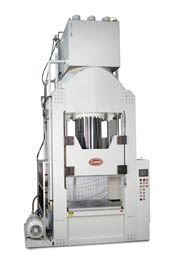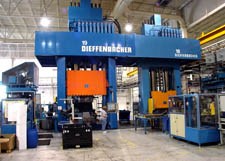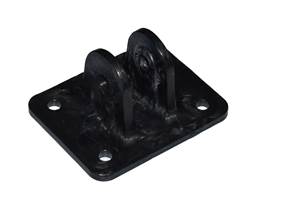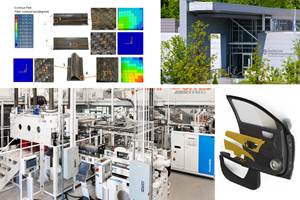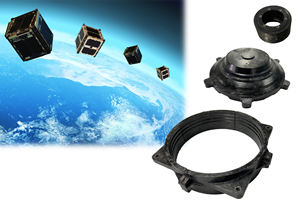Compression molding press technology adapts to meet new composite material processing requirements
Faster compression molding presses keep pace with new highly loaded, low-flow thermoplastics and thermosets.
As automotive engineers continue to search for ways to make lighter, less-costly components, the compression molding of composites has taken center stage in composites-for-metal substitution. Unlike other composites processing systems, the compression molding press is capable of reproducing fiber-reinforced plastic parts in significant volumes, with the accuracy, repeatability and speed to which the automotive industry has been accustomed in the stamping of metal parts. But press manufacturers have faced significant challenges recently, as OEMs and their partners in the composite molding and compounding community have developed materials capable of producing parts with thinner walls than the steel and aluminum parts they've replaced. This strategy for weight and cost reductions has prompted development of long-fiber- reinforced thermoplastics (LFRTs) and thermoset sheet molding compounds (SMCs) and bulk molding compounds (BMCs) with high fiber volume and/or quick-cure resin formulations. But the relatively poor in-mold flow characteristics of these materials has challenged the limits of existing compression molding press design, particularly in terms of press speed. "Right now, the materials are raising the bar," notes Manfred Bruemmer, sales manager for press manufacturer Dieffenbacher North America (Windsor, Ontario, Canada), "and machines are having to catch up." Press manufacturers are meeting the challenge with newer presses capable of keeping cycle times down as material viscosities go up.
Lighter, faster, cheaper
When composites began to replace automotive metals, the new materials were typically adopted into a part design previously optimized for steel. History was repeating itself. The aerospace industry had previously developed its first carbon composites in what became known as "black aluminum" designs -- optimized for aluminum but implemented with carbon-reinforced epoxy resins. The resulting parts were over-built in terms of performance properties, but reaped immediate benefits in weight loss. Taras Konawal, president of APEX Plastic Technologies (South Elgin, Ill., U.S.A.), a manufacturer's representative for CA Lawton (DePere, Wis., U.S.A.) compression molding presses, estimates that early automotive composites resulted in part weight reductions of 10 to 15 percent. As development programs progressed, however, parts were optimized for the new materials. Engineers redesigned them to minimize weight within the scope of the part's specified performance requirements.
With the advent of LFRTs and more reinforcement-intensive thermoset compounds, automotive engineers have had the opportunity to further adjust wall thickness and other part dimensions, not only in composites-for-metal changeovers but in existing composite designs as well. LFRTs (including glass mat thermoplastics or GMTs -- a common sheet form with fiberglass reinforcement) typically have fiber loadings of 30 to 50 percent with fiber lengths of 10 mm/0.4 inch and longer. In comparison, traditional thermoplastics are reinforced with milled or short fibers in lengths of 6 mm/0.25 inch or less. The longer fibers as much as double the impact strength and flexural modulus of comparable short-fiber compounds. LFRTs are thus moving into structural and semi-structural applications traditionally reserved for metals and thermoset composites, enabling significant reductions in part wall thickness (see "Thermoplastic Composites Making an Impact," CT February 2003, p. 20).
In thermoset applications, similar results are being achieved with greater percentages of fiber loading and the use of high-performance fibers, such as carbon. For example, bipolar plates compression molded for hydrogen fuel cells use a vinyl ester highly loaded with fiberglass and carbon fiber, the latter to provide the necessary electrical conductivity. Although fuel cells are in low-rate production primarily for stationary applications, they also are under active development for alternative-fuel automotive applications (see "Composites Energize Fuel Cells," CT November/December 2001, p. 40.) High-performance fibers and high loading add strength and rigidity to composite components. "Over the past five years, designers have reduced wall thickness [of some parts] by 30 to 40 percent," Konawal maintains. It is not unusual, today, for automotive engineers to design composite components with wall thickness around 2 mm/0.08 inch. Bruemmer notes, for example, a Dieffenbacher customer's composite engine covers with wall thickness of less than 2 mm/0.08 inch.
"Pretty much everything has been going thinner just to reduce the weight," says Konawal. "Long fibers and higher loading make the thinner parts possible."
Reducing the window
Use of these new materials reduces the process window -- the time available to accomplish the various stages in the molding process. A significant factor is heat loss. Parts with thinner walls require less material. In addition, poor flow has prompted designers to load the mold with a thinner charge that covers a greater area of the mold surface, requiring the material to flow a shorter distance during the molding process, which reduces the incidence of fiber breakage. The result is a much thinner charge with greater surface area that cools very quickly. The time it takes to load the charge and close the mold becomes a critical factor in success. "We must do everything we can to reduce pressure-less time," Bruemmer maintains. No less a factor are the newer, faster-curing resin systems in thermoset SMCs and BMCs, which have high appeal among automotive engineers as they continue to explore ways to directly diminish cycle times.
The prospect of unacceptable trade offs (e.g., more fiber breakage to reduce heat loss) puts a premium on press speeds. But many older presses simply cannot achieve the speeds needed to form parts of good integrity. "You can set up residual stresses if cooling viscosity increases too much before the press closes," explains Dan Buckley, director of product development for CA Lawton. "The stress can show up in warpage, fatigue or induced cracking. And this gets even more critical as the parts get thinner." One way to accommodate LFRTs in a slow press is to run higher temperatures in the mold, but this solution creates new problems, Buckley says. "That increases cycle times. And it may also affect residual stresses because of greater shrinkage back to room temperature." Automotive molders needed presses capable of short cycle times unanticipated in earlier press design.
To successfully mold LFRT components, press manufacturers have accelerated both the advance speed (closing the mold) and full-tonnage speeds (applying the molding pressures) in the hydraulic systems that currently predominate compression molding. A decade ago, a thermoplastic press might offer advance speeds of 400 mm/sec (950 inch/min) with full-tonnage speed up to 42 mm/sec (100 inch/min). Today, the advance speed for Dieffenbacher's latest DY series of hydraulic presses for thermoplastics can top 800 mm/sec (1,900 inch/min), and they operate at up to 80 mm/sec (188 inch/min) under full load conditions. The advance speed is achieved typically with an accumulator drive system, a standard technology that stores hydraulic oil under pressure while the pumps are unloaded. Accumulators allow the press to run at high speeds without having direct pump drives, which require a great deal of energy. Speeds and pressures in hydraulic presses are controlled with closed-loop motion control and pressure-controlled servo hydraulic manifold systems, integrated with programmable logic controllers and touch-screen operator interfaces. Advances in microprocessor technology translate to greater control as these advances are applied to presses.
Seeber USA (part of the Röchling Group, Duncan, S.C., U.S.A.) uses the new Dieffenbacher presses to make a composite underbody shield only 2.2 mm/0.087-inch thick. Seeber's 132,000-ft2 plant in Duncan (expanded in 2001 from 46,000 ft²) services several automotive customers, especially BMW, which has a manufacturing facility in the same area. The 90-cm by 65-cm (35-inch by 26-inch) underbody shield, made for the BMW Roadster Z4, uses Elastopreg (GMT-PP) low-density (1.067 g/cm2) GMT supplied by Quadrant Plastic Composites (Lenzburg, Switzerland). The Quadrant material for this application includes 23 percent fiber volume with continuous fiberglass mat in a tough polypropylene (PP) resin matrix. Seeber is manufacturing two other components on the same 1,800-ton Dieffenbacher DY series press. In up to three shifts per day, it must mold an average of 750 parts, including the underbody panels as well as battery boxes for the Roadster and battery boxes for the BMW SUV X5. Because this production rate translates to an average part cycle time under two minutes, good cycle times are essential at Seeber. Both battery boxes are molded to a wall thickness of 5 mm/0.2 inch, using GMT-PP with 30 percent fiberglass volume. Box dimensions for the Roadster are 45 cm by 40 cm by 20 cm (18 inches by 16 inches by 8 inches) and for the X5, 56 cm by 44 cm by 20 cm (22 inches by 17 inches by 8 inches).
Seeber oven-heats its GMT charges to 200°C/392°F. The press runs at an advance speed of 800 mm/sec (1,900 inch/min, which "looks almost like free-fall," reports Detlef Berg, Seeber process and project engineer. The press operates at 1,500 tons for the underbody shield and 500 tons for the battery boxes. (Operating pressure in hydraulic presses is determined through computer-operated control valves.) The company has achieved compression times of 20 seconds on the underbody shield, Berg reports, while the thicker walls of the battery boxes require 60-second compression times. The compression-molding step also accommodates manual placement of fastener grommets in the battery-box charge. Secondary processing -- punching mounting holes -- is performed on a 50-ton press supplied by Wabash MPI (Wabash, Ind., U.S.A.).
(Additional insight into the processing of LFRTs is available in the Composites Technology archives: see CT September/ October 2000, p. 33, and CT November/ December 1998, p. 18.)
Filled thermosets: hot and fast
Highly filled thermosets also demand fast press speeds, although not quite as fast as for thermoplastics. The primary differences between compression molding presses for highly viscous thermoplastic versus the low-viscosity thermoset composites are the heated tool and lower specific pressures needed for thermosets. For a given press size, Bruemmer notes, the lower pressure demands allow Dieffenbacher to fit a thermoset press with tables approximately 50 percent larger. However, the fact that the charge enters the press at room temperature does not mitigate the need for speed, especially under full tonnage. "If the press doesn't move fast enough," Bruemmer explains, "early crosslinking may occur on one side while the other side is still flowing into place. So you have to fight with eccentric loads."
A decade ago, a typical SMC press might have offered full-tonnage speeds up to 15 mm/sec (35 inch/min). High-speed thermoset presses today can be more than twice as fast, presenting full-tonnage speeds of 25 to 35 mm/sec (59 to 83 inch/min). CA Lawton has developed its Advanced Thermoset 700-ton press, with die space of 137 cm/54 inches by 112 cm/44 inches especially for molding the thermoset bipolar plates of hydrogen fuel cells; but recognizing that this press meets the requirements of LFRT molding as well, the company designed it for pressing speeds as high as 76 mm/sec (180 inch/min). Maximum advance speed on this press is 380 mm/sec (900 inch/min). The CA Lawton press also includes "bumpless transition control" to smooth press closure. Hydraulic presses typically go through two speed changes as the press closes, from the high-speed "advance" portion to an intermediate speed in which pressure is applied through jack rams or pumps at intermediate speed and low pressure; and from the intermediate portion to the full-tonnage portion that uses high-pressure pumps and low speed. In conventional presses, switching from one set of valves to another for each of these speed changes requires a pause in processing. Bumpless transition control eliminates these pauses, thus reducing cycle time. As a result material flow does not stop while transitioning -- an important feature for conventional materials, but even more important for materials where flow is a challenge. CA Lawton advertises cycle times for fuel cell bipolar plates of 10 to 12 seconds with this press.
Striking the right balance
But press manufacturers cannot boost speed to the detriment of precision. When molding thermoplastic composites, for example, running a press at too high a speed can create a "diesel effect," Bruemmer explains, where the material burns out in the corners of the part. Presses also must accommodate inconsistent conditions found in automotive fabrication lines, such as off-center charge loading. "You may not get standard load conditions in the press each time," says Bruemmer. A misaligned charge creates unanticipated pressure relationships within the mold. "Holding the platens parallel under these dynamic load conditions," Bruemmer maintains, is a critical design goal for compression-molding presses used for thin parts.
"The value of our machines," says CA Lawton's Buckley, "is not only that they have the high-speed capabilities, but that we don't give up anything in the nimbleness of the machine." The high-speed presses feature computer control for both velocity profiling, allowing for nonlinear velocity at full tonnage, and pressure profiling to keep from overpowering the charge. "Quite often we marry these two," Buckley continues. "For example, we might control speed via closed loop until the cavity is 95 percent full, then switch over and control the pressure via closed loop."
A primary measurement of precision in compression-molding presses is deflection, which is normally measured across the diagonal of the platen. Typically, the press is loaded with a charge covering two-thirds of the mold and a measurement is taken of any bending in the platens as the charge resists press closure. Conventional compression molding machines have allowed deflections of 0.25 to 0.33 mm/m (0.003 to 0.004 inch/ft). Today's Dieffenbacher presses offer deflection values of 0.12 to 0.17 mm/m (0.001 to 0.002 inch/ft). Furthermore, a parallelism control system holds the platen accurate to within 0.05 mm/m (0.0006 inch/ft). Bruemmer notes that, as an additional feature, "we can let the tool take over the guiding process of the machine."
Precision is no less critical in the processing of thermosets. With the bipolar plates of a hydrogen fuel cell, any variation in plate thickness is amplified as the plates are stacked together -- a few hundred plates in the stack of each fuel cell. "If it is thicker in the center and you're stacking the plates, it gets to be a lot -- you start to lose seals or break plates," explains Buckley. Furthermore, dimensional uniformity and consistency are critical to electrical capacitance, which is greatly affected by plate thickness. The CA Lawton Advanced Thermoset press limits deflection to a maximum of 0.067 mm/m (0.0008 inch/ft).
In addition to reducing deflection, press manufacturers must ensure precision and quality with consistent mold heating in thermoset presses. Tool heating affects flow, cure time, cycle time, completeness of cure, warpage and shrinkage. "Inconsistent cure rates across a tool cause different rates of shrinkage and builds in residual stresses," Buckley explains. Although such problems are not unique to newer, highly loaded thermosets, the poorer flow of the latter makes uniform heating all the more critical. "As a press manufacturer, we'll provide a variety of heat controls, from one zone up to very sophisticated zoning with very narrow margins in the movement of the heat," says Buckley. The 700-ton Advanced Thermoset press offers up to 22 zones, capable of keeping heat variation throughout the mold to within 1°F through the use of proprietary open-architecture zoning (thermocouples can be assigned to any heater or heater combination by the molding technician) and auto tune PID loops. Dieffenbacher presses possess a similar level of control. The company uses a supervision system, which reads out temperature gauges and enables the operator to modify heating as changes occur.
An electric future?
As automotive engineers pursue the means to make quality parts that are both lighter and lower in cost, one other avenue that press manufacturers are developing is a transition from hydraulic to electric power. While many injection-molding presses are now all-electric, compression molding has not yet made this move. Yet the advantages of electric over hydraulic mechanisms will likely prompt this development. A key advantage of electric presses is that, once the mold is clamped, energy need not be expended. Hydraulic presses, on the other hand, must maintain hydraulic pressure throughout the fabrication process. APEX's Konawal reports an estimated 70 to 80 percent energy savings with electric over hydraulic presses, both because of the energy-free clamping and because of the energy that must be expended to cool hydraulic fluids. Eliminating hydraulic fluids also provides a much cleaner operation.
But the transition is coming about quite slowly. The knowledge base and comfort level with hydraulics is a real obstacle, especially since parts manufacturers are already busy making adjustments in hydraulic designs to accommodate the new materials. Furthermore, components of the electric presses currently are much more expensive than hydraulic components. Buckley anticipates that CA Lawton will introduce small all-electric compression molding presses first and graduate slowly to larger designs. The clean operation of electric presses, for example, may allow them to make an early move into medical-parts applications first. By contrast, electric presses for automotive applications are perhaps a decade away.
More speed ahead
Konawal summarizes where press manufacturers continue to aim: "The faster and more precisely you can get the material into the press, the thinner and stronger the parts you'll manufacture." And of course, thinner, stronger parts translate into lower part costs and more attractive fuel economies, all without compromising safety - the kinds of features automotive engineers continue to aim for, as well.
Related Content
Hybrid process marries continuous, discontinuous composites design
9T Labs and Purdue applied Additive Fusion Technology to engineer a performance- and cost-competitive aircraft bin pin bracket made from compression-molded continuous and discontinuous CFRTP.
Read MoreClemson Composites Center: Working with industry to transform composites
Offering liquid and thermoplastic composites molding, LCA-weighted simulation, full testing to validate materials/process data cards, CCC’s digital life cycle approach unites manufacturing, microstructure, part property map and structural analysis.
Read MoreJEC World 2023 highlights: Innovative prepregs, bio-resins, automation, business development
CW’s Jeff Sloan checks in with JEC innovations from Solvay, A&P, Nikkiso, Voith, Hexcel, KraussMaffei, FILL, Web Industries, Sicomin, Bakelite Synthetics, Westlake Epoxy and Reliance Industries.
Read MoreComposite molding compound replaces Invar for lightweight small satellite structures
Patz Materials and Technologies and Lawrence Livermore National Laboratory developed a new monolithic optics housing with 80% less weight, near-zero CTE and the high-volume manufacturing required for commercial space.
Read MoreRead Next
From the CW Archives: The tale of the thermoplastic cryotank
In 2006, guest columnist Bob Hartunian related the story of his efforts two decades prior, while at McDonnell Douglas, to develop a thermoplastic composite crytank for hydrogen storage. He learned a lot of lessons.
Read MoreCW’s 2024 Top Shops survey offers new approach to benchmarking
Respondents that complete the survey by April 30, 2024, have the chance to be recognized as an honoree.
Read MoreComposites end markets: Energy (2024)
Composites are used widely in oil/gas, wind and other renewable energy applications. Despite market challenges, growth potential and innovation for composites continue.
Read More




